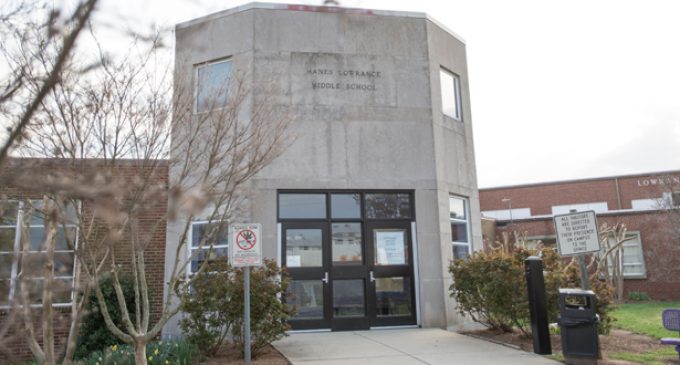School Board member maintains that Hanes and Lowrance schools were safe

Winston-Salem/Forsyth County School Board Member Elisabeth Motsinger said that she was concerned about the school system moving Hanes and Lowrance Middle Schools in the middle of the school year for what she amounts to fear-mongering.
“Obviously the safety of our children is the utmost importance to me, but to close the school when we have data that clearly says the school is safe for students and to spend those kind of resources when we have real needs in our district that are going unmet, doesn’t make any sense,” she said. “This will end up costing the district millions of dollars. The data absolutely says that the room air was safe and always have been safe.”
At the March 24 meeting, the Winston-Salem/Forsyth County School Board heard the final report on the vapor-intrusion testing from Will Service, an environmental toxicologist with Mid-Atlantic Associates. The company collected indoor air samples from 45 locations within the schools, and no contaminates exceeded residential screening levels in any of the locations.
According to WS/FCS documents, sub-slab soil vapor samples were collected from 31 locations to test for containments that maybe under the building. The chemical PCE was detected at levels exceeding screening levels in 14 samples. Those levels were compared to state targets for health risks, with only one of the 14 exceeding the target.
In February, the Winston-Salem/ Forsyth County School Board voted to move the students from the school because of a vapor intrusion from chemicals in the soil, although a consultant determined that those vapors were not at significant levels.
The board voted 7-2, with Motsinger and David Singletary dissenting, on Feb. 11 to move Hanes and Lowrance Middle Schools off their current site in response to concerns about safety at the site.
That move took place on March 2.
Hanes Magnet school was moved to two different places.
The sixth-graders were moved to Smith Farm Elementary, while the seventh- and eighth-graders moved to the former Hill Middle School, which hadn’t been used since the school merged with Philo Middle in 2012-2013.
Splitting Hanes up is a temporary move, according to WS/FCS documentation, with a goal of bringing all the grades back together on the same campus in Fall 2015.
Lowrance Middle moved to Atkins High School, a countywide magnet high school with a STEM focus.
For the 2015-2016 school year, Hanes Middle will be housed at the former Hill Middle School and Lowrance will stay at Atkins High School.
Documents made public by WS/FCS state that the school system became aware of possible contamination beneath the schools in 1995, when Kaba Ilco asked to install underground monitoring wells on the property.
The system placed emphasis on the fact that drinking water was not affected because the schools are served by a public water supply not drawn to the groundwater.
Indoor air quality tests have also been done since 2005. Studies found that there were elevated levels in roughly three classrooms in 2006.
The air inside Hanes and Lowrance schools was tested in May 2014 after Kaba Ilco and WS/FCS discussed installing a remediation system on the Hanes/Lowrance property and the possibility of WS/FCS building on the site. Those levels, analyzed by engineering firm S&ME, were found to be “below the applicable standards, and generally less than or equal to the prior tests results.”
“I spent a lot of time talking with DENR, both in Winston-Salem and Raleigh … two people from Piedmont Geological, and I’ve since talked to several environmental engineers and nobody supports closing the school in the scientific community. Given that it was a STEM school, I would especially hope that we pay attention to scientific data to drive our decision,” Motsinger quipped.
She went on to say that there are 93 sites like this in Forsyth County that are on the inactive hazardous waste site list and that Hanes/Lowrance is not one of them. She said that she feels the problem could have been fixed with education, without the “sensationalism of the Winston-Salem Journal and parents who did not live in the neighborhood.”
“To me, the public really needs to understand that all of the urban counties in the state have some of this contamination as a legacy. We used to not test, we used to not have NC DENR and the EPA, and regulations that said what you can and can’t test. So when people were pouring these chemicals directly in the dirt, they had no idea what the consequences would be.There will be no safe place for your children if we poison our water. That’s the big message. All of our children will be effected by the environmental choices we make,” Motsinger said. “There is no danger. It’s about concentration. Some soil vapor intrusion dissipates so fast that there really isn’t a danger for kids to be outside playing in the playground or in the grass. It’s not that I’m ignoring it. It’s not that I don’t care. The air quality of the building there is no different than my house, their house, where you go to work or where I go to work.”
The school board voted unanimously on March 10 to spend $15.5 million to build a new Lowrance Middle School on the campus of Paisley IB Magnet School. The money will come from a $42.6 million request from the Forsyth County Commissioners for building projects.
Board member Vic Johnson said that he feels the parents made the decision to close the school when they stopped sending their children.
“When over 100 kids a day started staying out of school, sometimes 180, that’s disruptive. They made a decision that they would not send their kids,” he said.
Johnson said that at the time the school board didn’t know how serious the problem was or if they could test every year. He said that ultimately determined why the move was needed, for him.
He said that Motsinger is allowed her opinion and he admits he doesn’t know the magnitude of the problem.
“The school is 65 years old. We can’t build anything else on the property. I felt we needed to move the kids since we had the space at another school,” he said. “This isn’t one of those right or wrong questions. My kids went to Lowrance and Hanes. I imagine if that situation rose at that point in time I would want my kids out of there. We don’t know what the problems could’ve been in later on. Safety is the number one thing I’m concerned about and I wouldn’t bet my life on it. You just don’t know.”
Unlike Johnson, Motsinger maintains that the children could have stayed in the school without being in danger.
“I would never send our kids to school if I thought it was not safe for them to be there. We didn’t close it (the school) because it was unsafe. It got closed for political reasons, but not for true safety reasons. It was fear, not reality,” she said. “If I thought that kids who lived there were unsafe, then I would be up in arms about it. The reality is that those kids don’t stop being our kids just because they’re not in school. They’re our kids 24 hours a day, seven days a week.”
Motsinger said that she feels that the money spent on testing, what she estimated as $85,000, could have been better used elsewhere in the school system.
“To spend that type of money to move them out of a safe school when we need books, we need our kids to learn how to read and we have children who are living in Winston-Salem who aren’t getting their needs met? That’s where I want our money to go. I have to protect resources to make that possible for them.”
The city’s Stormwater and Erosion Control department recently announced their newest project to measure soil that may be contaminated.
The city will implement monitoring wells in the area that will determine how far the pollutant plum surrounding Kaba Ilco has migrated and how it impacts surrounding residents and the city from 28th Street on down.
The company has signed an agreement with officials from the state to implement a plan to treat the soil and remove the vapors.
Stormwater Manager Keith Huff told citizens at a recent town hall meeting that the main pollutants found in the ground were tetrachloroethene, trichlorothene and 1-Dichloroethene, all common chemicals that can be found in common household agents. The solvents are used in dry cleaning, cleaning of metal machinery and to manufacture consumer products and chemicals.
Those vapors can come up through the soil, and in enough concentrations, can make its way through a slab in the buildings.
The city will sample the groundwaters, soil, soil vapor, surface water and the drinking water system in areas south of 28th Street.
For more information on a list of sites, visit http://portal.ncdenr.org/c/document_library/get_file?uuid=bc36cebd-0da1-4199-be4c-1044a7f1343c&groupId=38361.











